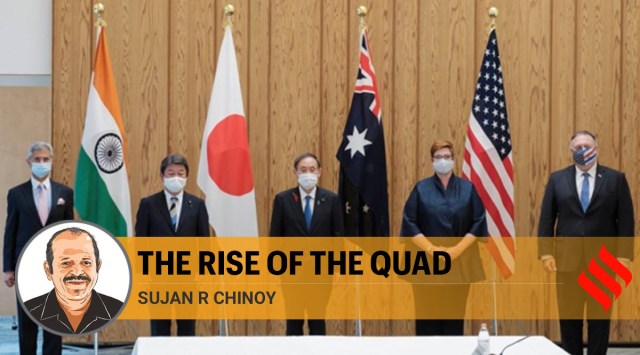- India
- International
Quad needs a definitive blueprint to have meaningful impact
The Quad Plus format should cater to the region’s economic needs, including infrastructure, connectivity and capacity-building. Without generous alternatives, many countries would continue to be drawn to China, as moths to a flame.
 From left to right, External Affairs Minister S Jaishankar, Japanese Foreign Minister Toshimitsu Motegi, Japanese Prime Minister Yoshihide Suga, Australian Foreign Minister Marise Payne and US Secretary of State Mike Pompeo pose for a picture before a four Indo-Pacific nations' foreign ministers meeting at the prime minister's office in Tokyo 2020. (AP/PTI Photo)
From left to right, External Affairs Minister S Jaishankar, Japanese Foreign Minister Toshimitsu Motegi, Japanese Prime Minister Yoshihide Suga, Australian Foreign Minister Marise Payne and US Secretary of State Mike Pompeo pose for a picture before a four Indo-Pacific nations' foreign ministers meeting at the prime minister's office in Tokyo 2020. (AP/PTI Photo)The second ministerial meeting of the four-nation Quadrilateral Security Dialogue (Quad) in Tokyo on October 6 has been followed by a decision to include Australia in the Malabar 2020 naval exercise after a gap of 13 years. The threat posed by China to the geo-strategic and geo-economic landscape of the Indo-Pacific region ranks alongside the challenge of the pandemic in terms of disruption. The pandemic has stoked Chinese aggression, from the East and South China Seas to eastern Ladakh, but it has also provided others with opportunities to cooperate in maritime security, cyber-security, data flows, quality infrastructure and healthcare.
That the “Indo-Pacific” concept has gained fresh currency should not come as a surprise. It is an inclusive and representative term that reflects the contemporary interconnectedness of trade, technology and supply chains in a wider region. By comparison, the “Asia-Pacific” represented the trans-Pacific strategic and economic impulses after World War II, and was confined to East and South-east Asia. Moreover, the Indo-Pacific is being redefined, ironically, by China’s Belt and Road Initiative (BRI), debt-trap diplomacy, fictional territorial claims and a divide-and-rule strategy. The historical experience of Indo-Pacific strategies of the colonial age can help provide deeper insight into the malefic impact of China’s neo-colonialism.
Beijing views the “Indo-Pacific” as a direct threat to the BRI, and in classical wei qi calculus, as an “encirclement” strategy.
During his recent visit to Malaysia, Chinese Foreign Minister Wang Yi criticised the Quad, stating that Washington was aiming to build an “Indo-Pacific NATO” through the Quad. The very fact that China no longer describes it as “headline grabbing” and “foam on the sea” that would “soon dissipate” is proof that the Quad is acquiring traction.
Editorial | Australia’s return shows Delhi is reconsidering deference to Beijing’s interests, giving primacy to its own.

One can expect China to use wei qi principles and guanxi (networks and connections) to weaken the Quad, especially in Japan and Australia. The economies of these two key Quad members remain heavily dependent on China. Japan’s efforts at economic decoupling and Australia’s endeavours to subject Chinese investments and influence-peddling to greater scrutiny should be lauded. In all likelihood, the new Yoshihide Suga government in Japan will hold PM Abe’s tough line on China, at least until the LDP election in September 2021 and the lower house elections later that year. Japan’s recent enabling agreements with Vietnam and Philippines for defence exports could lead to similar arrangements with Indonesia and Thailand. Hopefully, the Scott Morrison government in Australia will continue to receive full domestic support for its increasingly robust China policy.
Once a solitary voice, India’s concerns about the BRI are now echoed by several countries. India took the lead in banning Chinese apps. Notably, it was India’s decision that had elevated the Quad dialogue to ministerial-level in 2019. Yet again, it is India which has shed its reticence and decided to welcome Australia to the Malabar 2020 exercise.
India’s pull-out from the Regional Comprehensive Economic Partnership (RCEP) negotiations last year may have appeared self-injurious then, but subsequent developments have put into sharper relief the deleterious role of China-centric supply chains.
China’s actions have since led to the Resilient Supply Chain Initiative (RSCI) involving India, Japan and Australia, focussed on key sectors such as semi-conductors, pharmaceuticals, automobiles and telecommunications.
Opinion | C Raja Mohan writes: Engaging Quad partners on reforming China-centred economic globalisation is a rare opportunity for India
An ambitious China has consistently sought the expulsion of the US from its periphery. The US and others such as France and Britain are historically part of the region. The US has played a key role in the region’s stability and prosperity following the Second World War. US military presence prevented Japan from re-arming itself. It cautioned China against risking military adventurism across the Taiwan Strait that would have otherwise derailed its economic ascendance, and kept the peace on the Korean Peninsula for over six decades. Ironically, China, the biggest beneficiary of the trans-Pacific trade and investment flows, does not quite see it that way.
In the South China Sea, China’s preposterous claims, island-building spree and militarisation of oceanic space continue to grab headlines. China is a member of UNCLOS yet disregards its precepts. Vastly adept at concocting “historical evidence” to buttress claims, China has regularly used the wei qi strategy to fracture ASEAN consensus. As the only major power involved in the Code of Conduct negotiations, China will probe chinks in the armour of “ASEAN centrality” to exploit and shape outcomes.
The US position on the South China Sea is now fully in alignment with the Permanent Court of Arbitration (PCA) tribunal award of 2016. While it cannot restore status quo ante in the South China Sea, it does boost the morale of disputants such as the Philippines, who are routinely bullied by China.
In the Indian Ocean, China uses the cloak of anti-piracy deployments to maintain a quasi-permanent presence, with bases in Gwadar and Djibouti as beachheads for penetrating South Asia, the Gulf region and littoral Africa.
As was once the case in dealing with the xiongnu — barbarians — on its northern borderlands, China continues to employ ancient stratagems to pit one nation against another on its periphery to weaken and subjugate contending forces through guile and inducements.
Opinion | C Raja Mohan writes: Confusion reigns on what the Quad is and its future in India’s international relations
The Quad, having ensconced itself as the core of the Free and Open Indo-Pacific (FOIP) vision, now needs a definitive blueprint in order to have a meaningful impact. It should have a tough security-oriented core with a softer and inclusive exoskeleton that prioritises the developmental agenda. The Quad Plus format should cater to the region’s economic needs, including infrastructure, connectivity and capacity-building. Without generous alternatives, many countries would continue to be drawn to China, as moths to a flame.
Looking ahead, there is scope to convene a future Quad meeting in the 2+2 format, with diplomats and civilian defence officials participating at the level of director general. Such an expanded format could gradually be elevated to the level of vice minister and minister. A joint statement by the four countries at the next meeting of the Quad would also help consolidate the gains made so far.
This article first appeared in the print edition on October 21, 2020 under the title “The rise of the Quad”. The writer, a former Ambassador of India, is currently director-general of the Manohar Parrikar Institute for Defence Studies and Analyses. Views are personal
EXPRESS OPINION
More Explained
Apr 24: Latest News
- 01
- 02
- 03
- 04
- 05










































